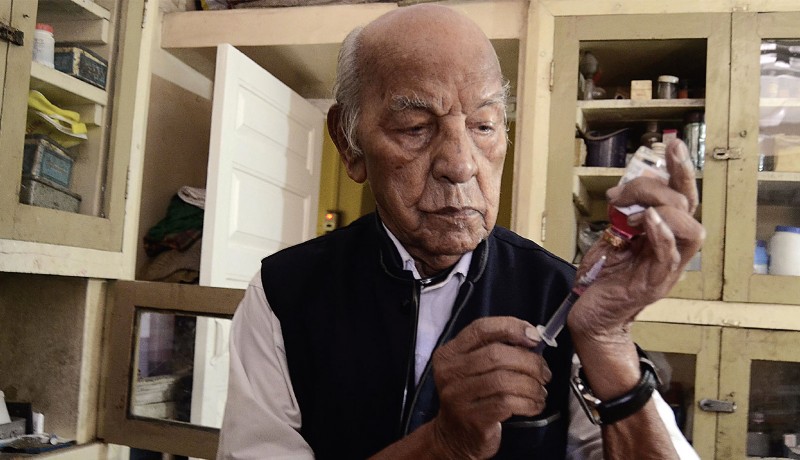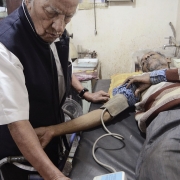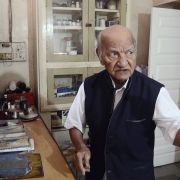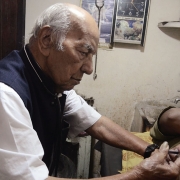
People

For almost 70 years, Dr Balwant Ghatpande has been healing the sick. Could there be a more healthy prescription for a long and fulfilling life? Suchismita Pai finds out
At 103 years of age, if you’re at a doctor’s clinic, chances are you’re a patient. But Balwant Ghatpande is no regular centenarian. At the clinic at Rasta Peth, in the heart of Pune, Ghatpande is the doctor; he’s practised here for the past 69 years.
With an assistant who has been with him for over 33 years, Dr Ghatpande still sees an average of 20 patients a day, and keeps his clinic open even on Sundays. His assistant Mangesh Darje says Dr Ghatpande prefers to attend on his patients all by himself, from taking blood pressure to administering injections and handing out medicines.
The doctor’s methods haven’t changed much in all these decades, nor has his clinic. The shingle that hangs outside the door, announcing that the doctor is in, looks worn and weathered. Rather than being outdated, it is a metaphor for an intuitive wisdom that blends with the centenarian’s experience in healing patients. It’s a potent prescription that’s never failed to work.
“Today, everyone wants instant gratification, and people do not have the patience to wait for the treatment to take its course. They prefer to suppress their symptoms rather than rest. They diagnose themselves and then run to a specialist rather than go to a general practitioner. Also, there are not as many GPs today as everyone super-specialises these days,” says Dr Ghatpande. “Everyone is a businessman and not a practitioner of healing any more. Throwing money at the problem does not fix your health issues.”
His clinic is housed in a double-storey building built by the doctor in 1962. Located in an older part of town, the building is called ‘Balwant Bhavan’. The clinic is on the ground floor and boasts a small outer room with old-fashioned table and chair, which the good doctor occupies. A man of few words, he motions to a patient to follow him into the examination room, which is exactly what you would see in a Hindi film of yesteryear.
When a patient emerges from the clinic, it’s with a little brown paper pouch in hand bearing his or her name scribbled on it. If that sounds a tad rustic, listen to what the doctor has to say. “Patients of yore had full faith in their doctor, who used to be their family physician, their counsellor and often a good friend of the family. The treatment was holistic and it took time. People made peace with loss of work and pay and let the body recover,” says Dr Ghatpande, who charges the princely sum of ₹ 30 to ₹ 60 for every consult.
Darje, the doctor’s assistant, says, “He doesn’t let me handle anything or even give injections. I just have to ensure that the medicines are stored in their right place and that the general order that has prevailed for decades is not disturbed. He even handles the money himself, keeping it in the drawer under the table, under lock and key. The same drawer stores the bills for the medicines and other important papers.”
There’s a chemist near the clinic that has been supplying medicines to Dr Ghatpande for the past 30 years. An employee at the store, who has known the doctor for 13 years, remarks, “He checks each bill and even remembers any carry-over or residual sums. He is very meticulous and we are used to this system.”
Dr Ghatpande has every reason to be set in his ways, for it was his ability to walk the straight and narrow that saw him through his medical education. As a young man in pre-Independent India, Ghatpande hailed from a poor family in Latur, in rural Maharashtra, but he was determined to acquire a medical degree. So he came to Pune and tutored other students to pay his way through medical school. It was, therefore, a proud day when he earned his degree from the government-run B J Medical School, later upgraded and renamed B J Medical College.
But the young doctor did not have the funds to set up a private practice just then, so he worked as a government medical officer from 1941 to 1948. While he was posted in hospitals across Maharashtra, he honed his skills and picked up valuable experience.
Then, in the wake of Independence and the shifting climate it created, Dr Ghatpande found himself back in Pune in 1948, where he started his private practice. While his clinic is on the ground floor, his home is on the upper storey, where he lives with his son Swanand and daughter-in-law. The old homestead has since seen two more generations of doctors.
“All three of my children became doctors, starting with my eldest daughter, who also married a doctor. They migrated to the US a long time ago. Both my sons and one grandson are also doctors. But there are no medical discussions at the dinner table,” he clarifies.
The medicine man takes hardly any medicines himself and has managed to shake off the shadow of diabetes that stalked him briefly, with exercise, diet and sheer will power. Except for a fracture in 1995, Dr Ghatpande claims to have never visited a doctor for any sort of illness. He believes in a strict routine that begins with exercise for an hour every day and then a coconut oil massage. He follows this up with a cold bath and breakfast, and he is ready to greet the day!
An avid reader of all newspapers and medical papers, Dr Ghatpande does not wear spectacles and reads late into the night. Television is restricted to the news, never for entertainment; he also believes vacations are for the idle rich.
In fact, he doesn’t speak much and rarely expresses any wishes or desires. When his wife was unwell, he buried himself in his work, and it was Swanand who tended to his mother, who eventually passed away. Dr Ghatpande’s daily routine hasn’t varied for as long as his daughter-in-law Pratibha can remember. “He is in the clinic like clockwork at 10 o’clock and examines patients till 2 pm,” she shares. “Between 2 pm and 2.30 pm, he comes upstairs to the residence and takes a short nap, post-lunch. After he wakes up, he drinks his tea and returns to the clinic, where he remains till 10 pm.”
Swanand adds, “His needs are few and we really have to do nothing for him, either financially or physically. We only have to ensure his food is soft and to his liking. He rarely speaks more than two sentences a day but follows the news avidly. He knows what’s happening but somehow seems financially insulated. He has not raised his consultation fees in decades.”
At a time when most people prefer to spend their silver years relaxing, travelling and indulging in recreational activities, Dr Ghatpande prefers to spend all his time healing people. Indeed, our centenarian is a simple man with a simple goal: “I will never retire and will practise medicine till my last breath. As long as my patients need me, I will be there for them.”
Photos: Ravindra Joshi Featured in Harmony — Celebrate Age Magazine January 2018
you may also like to read
-
For the love of Sanskrit
During her 60s, if you had told Sushila A that she would be securing a doctorate in Sanskrit in the….
-
Style sensation
Meet Instagram star Moon Lin Cocking a snook at ageism, this nonagenarian Taiwanese woman is slaying street fashion like….
-
Beauty and her beast
Meet Instagram star Linda Rodin Most beauty and style influencers on Instagram hope to launch their beauty line someday…..
-
Cooking up a storm!
Meet Instagram star Shanthi Ramachandran In today’s web-fuelled world, you can now get recipes for your favourite dishes at….










